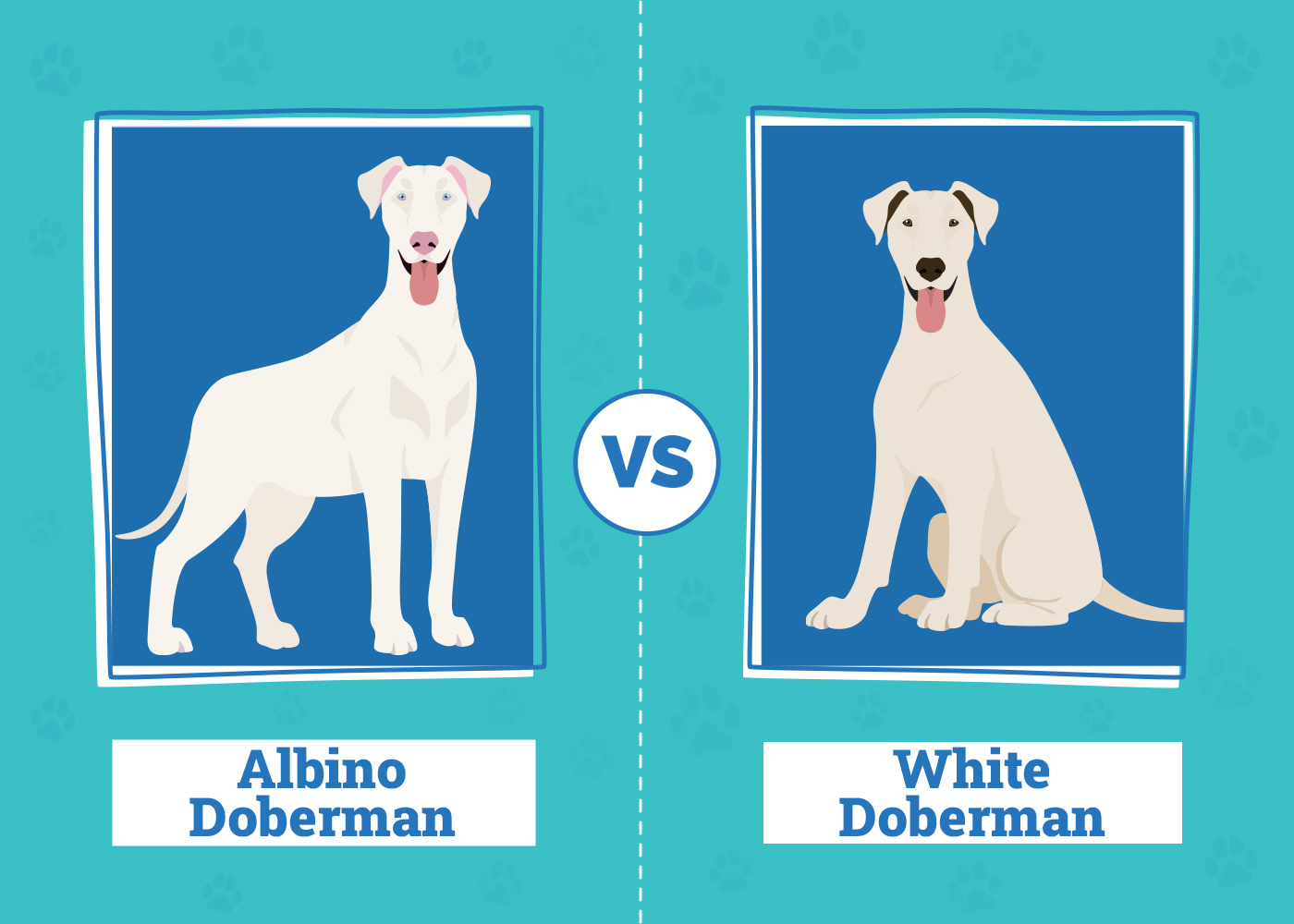The History of White Doberman Pinschers
Origin of the White Doberman Pinscher
The history of the White Doberman Pinscher is as intriguing as the breed itself. These unique canines are believed to have originated from genetic variations in standard Doberman colors. The first registered White Doberman with the American Kennel Club (AKC) was Padula’s Queen Sheba, born on November 10, 1976. Sheba was the descendant of black and rust-colored parents, sparking questions regarding her lineage and the legitimacy of her being a purebred Doberman.
As it turns out, the White Doberman gene is tied to a mutation in the SLC45A2 gene, a variant known for causing a type of albinism, leading to their light cream coats, pink noses, and striking blue eyes. While these dogs have often been mistaken for true albinos, they retain some pigmentation, differentiating them from classic albino breeds.
Intriguingly, historical references to light-colored Dobermans date back to at least the 1930s, suggesting that variations existed long before Sheba’s registration.
Breeding Challenges and Controversies
The journey to breed White Dobermans has not been without contention. Early breeders faced significant backlash from the Doberman Pinscher Club of America (DPCA), which in 1982 amended its breed standards to exclude colors beyond the traditional black, red, blue, and fawn. Concerns arose regarding health issues, inbreeding, and overall temperament.
Some of the primary challenges and controversies include:
- Inbreeding Concerns: The lineage of White Dobermans stems largely from Sheba and her offspring, leading to fears of limited genetic diversity.
- Health Issues: Studies indicate a higher tendency for skin tumors and other health concerns in White Dobermans compared to their traditionally colored counterparts.
- Ethical Breeding Practices: Some breeders capitalize on the unique color, prompting a dispute regarding the morality of breeding for appearance over health.
Despite the challenges, passionate advocates for White Dobermans continue to emerge, highlighting their loving nature and compatibility with various families. They argue that like any other breed, White Dobermans deserve care, love, and a chance at life.

Characteristics of White Doberman Pinscher Puppies
Physical Appearance
White Doberman Pinscher puppies are a stunning sight to behold. Unlike their more commonly recognized counterparts, these puppies typically showcase a light cream color with distinct white markings. Here are some key features to note about their appearance:
- Coat Color: Light cream with white markings, giving them a unique, elegant look.
- Eyes: Striking blue eyes, which are an identifier of their genetic background, as this color is attributed to the presence of some pigmentation.
- Nose and Lips: They have a pink nose and pink-lipped rims around their eyes, adding to their unique charm.
- Overall Build: Similar to standard Dobermans, they have a muscular and athletic build with a sleek, elegant stature.
These features not only make them visually striking but also set them apart in a breed that is already known for its grace and poise.
Temperament and Behavior Traits
When it comes to temperament, White Doberman puppies share the quintessential traits that define the breed while also exhibiting some unique characteristics. Here’s what new owners might find:
- Loyalty: White Dobermans are known for their strong sense of loyalty, often forming deep bonds with their families.
- Intelligence: They are highly trainable due to their sharp intellect. This trait makes them excellent candidates for obedience training and various dog sports.
- Playfulness: As puppies, they are often energetic and playful, demanding engagement and plenty of playtime.
- Sensitivity: Some reports suggest that they may be a bit more sensitive compared to their colored counterparts, especially in terms of reactions to bright light due to their photosensitivity.
As with any breed, early socialization and exposure to different environments are crucial. They thrive in a loving and structured environment, making them rewarding companions for families who can give them the attention they need.

Health Considerations for White Doberman Pinscher Puppies
Genetic Health Concerns
When it comes to White Doberman Pinscher puppies, there are crucial health considerations that potential owners must take into account. These unique dogs are, in fact, classified as tyrosinase-positive albinoids. This means that while they do have some pigmentation, they face a range of health issues commonly associated with albinism. Some critical concerns include:
- Photosensitivity: White Dobermans are particularly sensitive to light, often leading to discomfort in bright environments. Many owners have noted that their dogs squint and may become anxious if exposed to excessive sunlight.
- Skin Issues: They are more prone to sunburn, skin lesions, and an increased risk of skin tumors. A study indicated that out of 20 white Dobermans, 12 had tumors, a stark contrast to only one in 20 among standard colors.
- Temperament Problems: Due to visual impairments associated with albinism, some of these dogs may exhibit behavioral challenges, such as fear-based biting. Early socialization can help manage such tendencies.
Care and Maintenance Tips
Given these health concerns, it’s crucial for owners to adopt a proactive approach to care and maintenance. Here are some effective tips:
- Limit Sun Exposure: Whenever possible, keep your White Doberman indoors during peak sun hours, typically between 10 AM and 4 PM.
- Use Dog-Friendly Sunscreen: Consider applying sunscreen to any exposed skin, especially on the nose and ears, to prevent sunburn.
- Regular Vet Check-Ups: Schedule regular health check-ups to monitor for skin conditions and other potential health issues.
- Eye Protection: Invest in dog-specific sunglasses designed to protect their sensitive eyes from bright light.
By being aware of these genetic health challenges and providing attentive care, White Doberman owners can help ensure their furry companions live healthy, happy lives.

Adoption and Ownership of White Doberman Pinscher Puppies
Finding Reputable Breeders
When considering the adoption of a White Doberman Pinscher puppy, finding a reputable breeder is crucial. White Dobermans have garnered a niche market, often attracting unscrupulous breeders who prioritize profit over the health and well-being of the dogs. Here are some tips to help you locate a responsible breeder:
- Research Thoroughly: Use online resources to look for reputable breeders who are members of the Doberman Pinscher Club of America (DPCA) or similar organizations. These breeders typically adhere to ethical breeding practices.
- Ask for References: Don’t hesitate to ask for references from previous puppy buyers. Hearing experiences from others can provide valuable insights.
- Visit the Facility: A responsible breeder should allow you to visit their breeding facility. This gives you the opportunity to see the conditions in which the puppies are raised and interact with the pup’s parents.
- Health Testing: Ensure the breeder provides health clearances for the puppy’s parents, especially regarding genetic conditions associated with albinism.
Responsible Ownership Practices
Owning a White Doberman Pinscher requires a commitment to their unique needs, given the associated health challenges. Here are several responsible ownership practices to adopt:
- Regular Vet Check-Ups: Schedule annual health check-ups to monitor skin issues and check for any signs of tumors or other health concerns.
- Sun Protection: As White Dobermans are prone to sunburn, investing in dog-specific sunscreen and limiting outdoor time during peak sunlight hours is essential.
- Socialization and Training: Early socialization and obedience training can help address potential temperament issues. Expose your puppy to a variety of environments and people to enhance their confidence.
- Support from the Community: Join local Doberman clubs or online support groups. Engaging with other Doberman owners can provide advice, support, and opportunities for socialization.
By following these guidelines, you can ensure a healthier and happier life for your White Doberman Pinscher, creating a lifelong bond filled with joy and companionship.

Myths and Misconceptions about White Doberman Pinschers
Debunking Common Myths
White Doberman Pinschers have garnered their fair share of myths and misconceptions over the years. It’s essential to separate fact from fiction, especially for prospective owners. Here are some common myths debunked:
- Myth: White Dobermans are True Albinos Fact: White Dobermans are not true albinos in the classic sense. They are actually light cream with some pigmentation, characterized by their blue eyes and pink noses. True albinism involves a complete lack of pigment, resulting in pink eyes.
- Myth: They Are More Prone to Deafness Fact: Contrary to popular belief, White Dobermans are not any more likely to be deaf than other colored Dobermans. This myth originated from a long-standing assumption that albinism was linked to hearing loss, which has since been debunked.
- Myth: They Have a Shorter Lifespan Fact: There is no conclusive evidence that White Dobermans have a shorter lifespan compared to their colored counterparts. While the average Doberman lifespan is between 10-13 years, contributing factors such as genetics and health care play significant roles across all colors.
Clarifying Misunderstandings
Beyond the myths, there are also misunderstandings regarding the care and treatment of White Dobermans. Here are some clarifications to keep in mind:
- Health Issues: While they face heightened risks for certain health problems like skin cancer and photosensitivity, many responsible owners successfully manage these through regular vet check-ups, sun protection, and proper care practices.
- Temperament: There’s a misconception that White Dobermans have poor temperaments. In reality, temperament is primarily determined by training and socialization. Many White Dobermans are as loving and loyal as their colored peers.
- Breeding Ethics: Misunderstandings also exist regarding breeding practices for White Dobermans. While unethical breeding does occur, there are reputable breeders focused on health and well-being, adhering to ethical breeding standards.
Understanding these myths and misconceptions can help guide prospective owners in making informed decisions about welcoming a White Doberman Pinscher into their homes.

Understanding the Popularity of White Doberman Pinscher Puppies
Celebrities and White Doberman Pinschers
The charm and elegance of White Doberman Pinschers have caught the attention of various celebrities, contributing significantly to their popularity. With their exquisite appearance and unique coloring, these dogs stand out and have found their way into the hearts of famous owners.
For example, several actors and influencers have proudly shared their experiences with White Dobermans on social media platforms. Celebrity endorsements can enhance a breed’s appeal, making it highly desirable among fans and dog lovers alike. The connection between these well-known figures and White Dobermans can inspire potential owners to consider adopting one for themselves.
Furthermore, owning a White Doberman Pinscher often evokes admiration, leading to questions and discussions about the breed’s fascinating history and genetic makeup—a topic that interests many dog enthusiasts.
Social Media Influence and Trends
In today’s digital age, social media plays a critical role in shaping dog ownership trends, and White Dobermans are no exception. Their striking looks often make them irresistible subjects for photography, resulting in visually stunning content that garners attention on platforms like Instagram and TikTok.
Here’s how social media contributes to their growing popularity:
- Visual Appeal: With their light cream coats and striking blue eyes, White Dobermans are naturally photogenic, attracting likes and shares.
- Community Engagement: Online groups and pages dedicated to Doberman enthusiasts foster discussions that promote awareness about the unique traits and health care needs of White Dobermans.
- Trending Hashtags: Using popular dog-related hashtags showcases the breed and aids prospective owners in connecting with the community.
The interaction between celebrities, social media, and the White Doberman Pinscher breed highlights a dynamic trend that not only boosts interest but also promotes conversations about responsible ownership and breed-specific care. As more enthusiasts share their experiences online, the admiration for these dogs continues to grow.

Leave a Reply